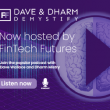Banking super-apps, marketplaces, ecosystems and platforms
I’m pretty confident most people will have used the terms super-app, marketplace, ecosystem and platform interchangeably at some point, or may be confused by what the differences are between them.

You should always have a clear understanding of exactly what you’re building before you get started
This is OK if it’s a general discussion, but if it’s part of your strategy or the focus of your project, then it’s best to be clear.
In the past year, I’ve spoken to a number of banks in the UK who are building “marketplaces” or “ecosystems”, and one that aspires to build a “super-app”. Yet in each case, these terms are often thrown around without a clear explanation.
As always, I try to define them in a way a non-technical person can understand. I would define them therefore as:
Super-app: An app that has a key (core) functionality and lots of associated functionality. For example, WeChat’s core is messaging, beyond that it also offers voice calls, photo sharing and other social apps as well as payments. Its vision summarises this as “tech for social”.
Marketplace: A type of platform that connects buyers and sellers together. Good examples of this are Amazon, eBay and Airbnb.
Ecosystem: A network of interconnected solutions. For example, Google provides an internet search engine, phones, smart speakers and other devices that can interact with each other. So, asking a smart speaker for the weather leverages its search engine. With Google’s acquisition of Nest, the ecosystem expanded to include security devices, heating controls and more, all of which can be interacted with via a phone or smart speaker.
Platform: A set of functionalities that are API enabled so that third parties can leverage them to create their own solution. Obvious examples here are Android and Windows.
Where it gets tricky is when they overlap. So, a super-app can become a platform by opening up APIs for third parties to extend their own functionality. The same goes for an ecosystem.
Aside from the definitions, what’s more interesting is whether banks can succeed at implementing any of them. Financial super-apps are the “re-bundling” of bank and third-party financial solutions, typically fintechs. In the past, banks did this by white-labelling or partnering. For example, most banks white-label insurance, and they partner for things like vehicle recovery on those policies. So, one could argue banks have essentially been super-apps for a long time, and this is something they should be able to deliver in app form. However, as we have seen with initiatives like “single customer view”, working with different parts of the same bank can be harder than working with third parties.
Some banks like TSB have created marketplaces. For me, the challenge with these is the curation of buyers/sellers. It’s the classic chicken and egg problem: buyers want a choice of lots of sellers, and sellers want access to lots of customers. This can be successful with a large bank as sellers have access to a large number of customers. However, there are significant challenges when it comes to scaling and making this profitable for the bank. My good friend, Paul Loberman, says that there has to be significant effort to engage users and introduce them to the right solutions at the right time. Banks can’t take a “field of dreams approach”. That is, “build a marketplace and they will come”!
Open banking has pushed banks into becoming platforms. Those that want to go further and make it part of their strategy have progressed towards a wider set of APIs essentially offering BaaS (Banking-as-a-Service). Again, this is a good strategy for a large bank that can leverage economies of scale, or a small bank that can clearly differentiate their services for a profitable niche (e.g. lending to house builders).
In my discussions, an ecosystem is something that banks typically get confused with marketplaces or platforms. I’ve yet to find one in banking.
Each of these terms aren’t “projects” or features of the bank, they are business strategies that must have a supporting business model and typically will require different parts of the bank to work together. And here lies the biggest challenge. A mortgage or credit card division has its own goals to meet, and may not be quite so concerned about enabling APIs to become a platform or integrating its services into a super-app. These strategies will require a long-term vision, investment and patience, and above all confidence that the bank can make this work.
However, the goal for a bank could be to test the water (feasibility) or to drive innovation. In one of my conversations, I was asked how many customers my product (AskHomey) could bring to the bank’s innovation project. In the end, it all comes down to numbers, and at some point the cost is too much or the profit is too small.
There seems to be new words and acronyms being used almost every week, so it’s no wonder terms can be confusing. You may or may not agree with my definitions too, and that’s OK. This week, I’m just saying it’s good to have a clear understanding of exactly what you’re building and ensure all teams know what you are and are not doing.
Also, don’t underestimate the why. This is not only important to staff but third parties that could be part of the strategy. It’s important that the bank has a clear north star if this is strategic, else it will most likely be another project that doesn’t succeed. This seems obvious, but from my experience, it’s not always the case!
About the author
Dharmesh Mistry has been in banking for more than 30 years both in senior positions at Tier 1 banks and as a serial entrepreneur. He has been at the forefront of banking technology and innovation, from the very first internet and mobile banking apps to artificial intelligence (AI) and virtual reality (VR).
He has been on both sides of the fence and he’s not afraid to share his opinions.
He founded proptech start-up AskHomey (sold to a private investor in spring 2023) and is an investor and mentor in proptech and fintech. He also co-hosts the Demystify Podcast.
Follow Dharmesh on Twitter @dharmeshmistry and LinkedIn.
Read all his “I’m just saying” musings here.












































